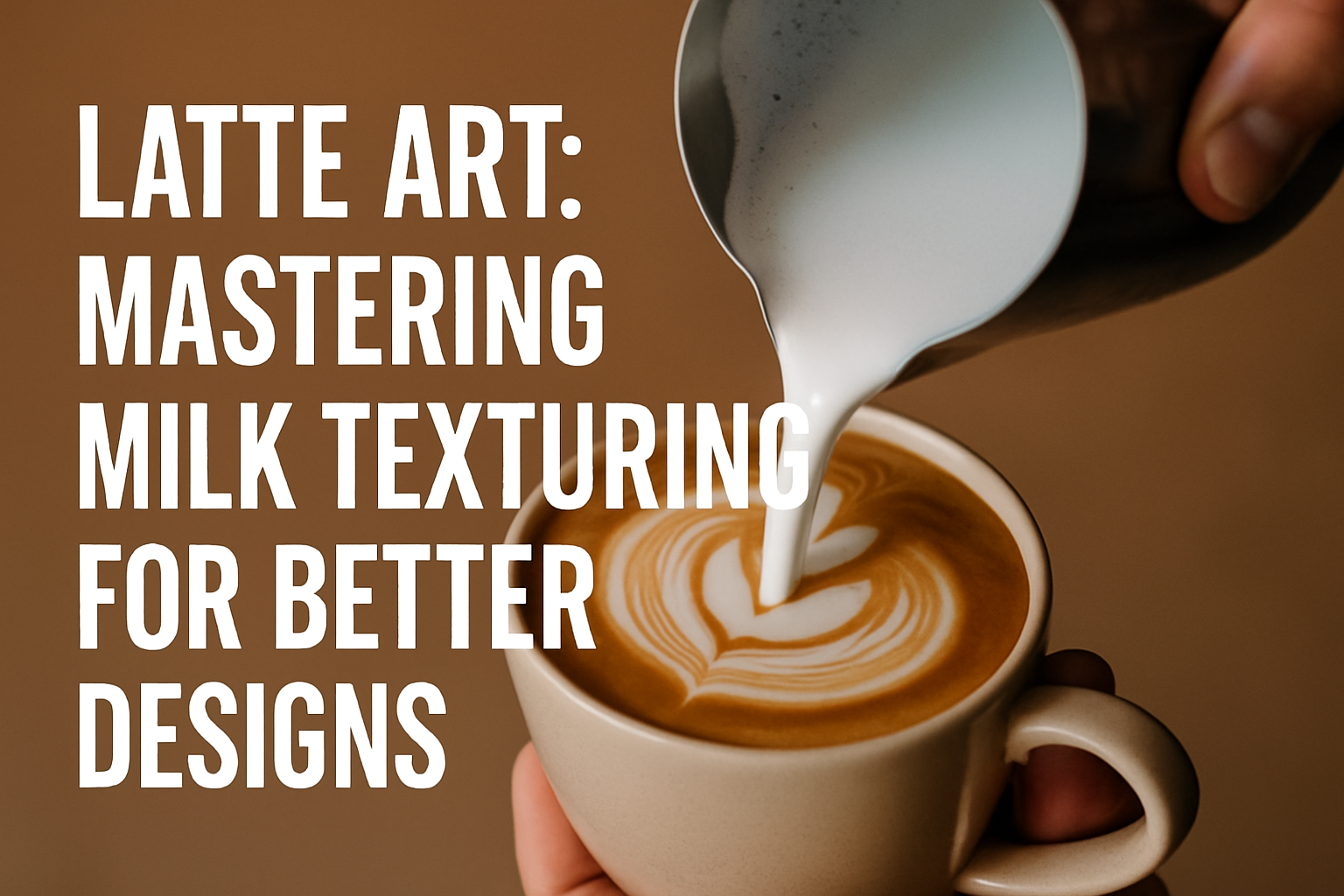Before you can pour beautiful hearts, tulips, or rosettas, you must first master the foundation of latte art: perfectly textured milk. It’s not just about creating pretty patterns — milk texture directly affects the taste, mouthfeel, and appearance of your drinks.
Many beginner baristas focus on pouring techniques but struggle with latte art because their milk texture is off.
Either the foam is too thick and bubbly, or it’s flat and watery. In this guide, you’ll learn how to steam milk like a pro, understand what makes microfoam ideal, and develop habits that lead to consistent results.
Why Milk Texture Is Crucial for Latte Art
Latte art relies on microfoam, a silky, shiny milk foam made of tiny bubbles that are nearly invisible. This texture allows the milk to:
- Blend seamlessly with espresso
- Hold together during pouring
- Create clear, high-contrast designs
- Provide a smooth, luxurious mouthfeel
If the milk is too foamy or too thin, it won’t flow correctly, and your design will break, sink, or look distorted. Proper milk texture isn’t just important for aesthetics — it defines the quality of the entire drink.
Understanding Microfoam
Microfoam is milk that’s been gently aerated and emulsified through steaming. It has a texture like wet paint or liquid velvet.
Key characteristics:
- Glossy and smooth surface
- No visible bubbles
- Light, creamy consistency
- Fluid enough to pour, but thick enough to float on espresso
You should be able to tilt the pitcher and see the milk move like silk, not like foam sitting on top.
The Science Behind Steaming Milk
When you steam milk, two main processes happen:
- Stretching (aerating): Introducing air into the milk
- Texturing (emulsifying): Integrating that air into the liquid to create microfoam
Milk contains proteins and fats that stabilize bubbles during steaming. Heating the milk to around 60–65°C (140–150°F) is ideal for flavor and texture. Overheating burns the proteins and leads to a flat or dry texture.
For best results:
- Whole milk provides the best texture and sweetness
- Alternative milks vary in behavior — oat milk is the most barista-friendly
- Cold milk and a cold pitcher give you more control and time
Step-by-Step: How to Steam Milk for Latte Art
1. Fill the Pitcher
Use cold milk, and fill the pitcher to just below the spout. For a 12 oz pitcher, about 6–8 oz of milk is ideal.
Don’t overfill — milk expands as it’s steamed, and too much can spill or steam unevenly.
2. Purge the Steam Wand
Always release steam briefly before inserting the wand. This clears out any condensation and ensures dry steam.
3. Position the Wand for Stretching
Insert the steam wand just below the surface of the milk, near the side of the pitcher.
Turn the steam on full blast, and listen for a gentle “chirping” or “paper-tearing” sound — this means air is entering the milk.
Stretching should last 1–2 seconds. After that, immediately sink the wand slightly deeper to stop adding air.
4. Create a Vortex (Texturing Phase)
Tilt the pitcher slightly and position the wand to create a whirlpool or spinning motion in the milk. This vortex helps break down any larger bubbles and mix the foam evenly.
Keep the wand submerged and allow the milk to heat gradually to around 60–65°C (or until the pitcher is too hot to hold comfortably).
Don’t go above 70°C — overheating flattens the texture and dulls flavor.
5. Turn Off the Steam and Wipe Down
Turn the steam off before removing the wand to avoid splattering. Then wipe the wand immediately with a clean, damp cloth and purge again to clear milk residue.
6. Polish the Milk
Tap the pitcher on the counter to pop surface bubbles, then swirl vigorously to integrate the foam.
Well-textured milk should look shiny and uniform — like melted ice cream or wet paint.
Troubleshooting Common Milk Texture Problems
Problem: Big Bubbles or Dry Foam
Cause: Too much air introduced during steaming
Fix: Stretch for only 1–2 seconds. Keep the wand closer to the surface without splashing.
Problem: Flat, Thin Milk
Cause: Not enough air or over-steaming
Fix: Add air right at the beginning. Use cold milk to give yourself more time. Don’t let the milk overheat.
Problem: Milk Separates Quickly
Cause: Poor integration of foam and liquid
Fix: Create a stronger vortex during steaming. Swirl well before pouring to keep texture consistent.
Problem: Milk Is Too Hot to Drink
Cause: Overheating past 70°C
Fix: Stop steaming earlier. Use a thermometer or touch-test until you build muscle memory.
Tips for Consistent Microfoam
- Use whole milk when learning — it’s the most forgiving
- Always start with cold milk and a cold pitcher
- Keep your wand clean between every use
- Use the same pitcher and amount of milk during practice to develop consistency
- Swirl the milk right before pouring to maintain texture
How Milk Texture Affects Latte Art
Your milk texture determines how your design looks and flows.
- Too thick: Milk piles on the surface, makes blobs
- Too thin: Milk sinks into the crema, making the art disappear
- Just right: Milk floats, integrates with crema, and forms sharp, clean lines
Ideal microfoam allows you to control the flow, shape your design, and finish with contrast and clarity.
Different Textures for Different Drinks
Not all drinks require the same milk texture. For example:
- Flat white: Thin microfoam, glossy and velvety
- Cappuccino: More foam, but still smooth — thicker layer
- Latte: Medium microfoam for balance
- Macchiato: Dense foam spooned on top
As a barista, adjusting your steaming based on the drink improves both texture and taste.
How Alternative Milks Affect Texture
Plant-based milks behave differently because they lack the same proteins and fats as dairy. Here’s a quick overview:
- Oat milk: Best for latte art; good stretch and sweetness
- Almond milk: Can be watery; less stable foam
- Soy milk: Decent stretch but may curdle with acidic espresso
- Coconut milk: Less ideal; often separates quickly
Always use barista versions of plant milks if available — they’re formulated for steaming and latte art.
Practicing Milk Texturing Without Wasting Coffee
While learning, you don’t need to use espresso every time.
Try this:
- Fill your pitcher with cold water and a drop of dish soap
- Steam it like you would milk
- Practice creating microfoam and pouring into an empty cup
This helps you build steaming skills without using expensive ingredients.
Final Thoughts: Texture Is the Foundation of Great Latte Art
Every tulip, rosetta, or heart begins with great milk. Texture gives you the canvas to pour on, the contrast to bring designs to life, and the mouthfeel that keeps customers coming back.
Before chasing complex patterns, focus on consistency. Steam. Pour. Repeat. With time, you’ll develop the touch, sound, and feel of perfect microfoam — and your latte art will show it.
Remember: good texture isn’t just a technique. It’s a skill that reflects care, attention, and pride in your craft.

Marcelo Rodrigues is a passionate barista with over 7 years of experience in specialty coffee. He’s worked in top cafés, led barista training sessions, and now shares practical tips to help beginners and coffee lovers improve their skills. Through this blog, Marcel makes the world of coffee more accessible—one cup at a time.

